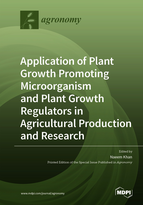Application of Plant Growth Promoting Microorganism and Plant Growth Regulators in Agricultural Production and Research
A special issue of Agronomy (ISSN 2073-4395). This special issue belongs to the section "Agricultural Biosystem and Biological Engineering".
Deadline for manuscript submissions: closed (15 November 2020) | Viewed by 181374
Special Issue Editor
Interests: plant-microbe interactions; biofertilizer technology; abiotic stresses; plant breeding; plant protection; soil microbiology; phytohormones; phytoremediation and metabolic responses of plants to environmental stresses
Special Issues, Collections and Topics in MDPI journals
Special Issue Information
Dear Colleagues,
Plant growth-promoting microorganisms (PGPMs) are groups of rhizosphere microorganisms capable of colonizing the root environment. Some of the microbes that inhabit this zone are bacteria and fungi that are capable of colonizing efficiently roots and rhizosphere soil. These microorganisms can be used as biofertilizers for improving agricultural production even under stressful environmental conditions. In contrast to PGPMs, plant growth regulators (PGRs) are chemical compounds that significantly affect the growth and differentiation of plant cells and tissues. They function as chemical messengers for intercellular communication and play a vital role in plant signaling networks as they are involved in the plant developmental process and a wide range of biotic and abiotic stress responses.
The application of PGPMs and plant growth regulators/hormones or the synthesis of PGRs and signal transduction, perception, and cross-talk create a complex network that plays an essential role in the regulation of plant physiological processes. A better understanding of the mechanism of action of PGPMs and PGRs and their roles in plant growth and development, interaction and independence in their action, and hormonal cross-talk under stresses is essential for agricultural production and research. Therefore, this Special Issue aims to collect research papers and reviews that promote this aspect of plant growth-promoting microorganisms and plant growth regulators.
Dr. Naeem Khan
Guest Editor
Manuscript Submission Information
Manuscripts should be submitted online at www.mdpi.com by registering and logging in to this website. Once you are registered, click here to go to the submission form. Manuscripts can be submitted until the deadline. All submissions that pass pre-check are peer-reviewed. Accepted papers will be published continuously in the journal (as soon as accepted) and will be listed together on the special issue website. Research articles, review articles as well as short communications are invited. For planned papers, a title and short abstract (about 100 words) can be sent to the Editorial Office for announcement on this website.
Submitted manuscripts should not have been published previously, nor be under consideration for publication elsewhere (except conference proceedings papers). All manuscripts are thoroughly refereed through a single-blind peer-review process. A guide for authors and other relevant information for submission of manuscripts is available on the Instructions for Authors page. Agronomy is an international peer-reviewed open access monthly journal published by MDPI.
Please visit the Instructions for Authors page before submitting a manuscript. The Article Processing Charge (APC) for publication in this open access journal is 2600 CHF (Swiss Francs). Submitted papers should be well formatted and use good English. Authors may use MDPI's English editing service prior to publication or during author revisions.
Keywords
- Plant growth-promoting microorganisms
- Plant growth regulators
- Crop plants
- Cross-talk
- Signaling network
- Stress environments






